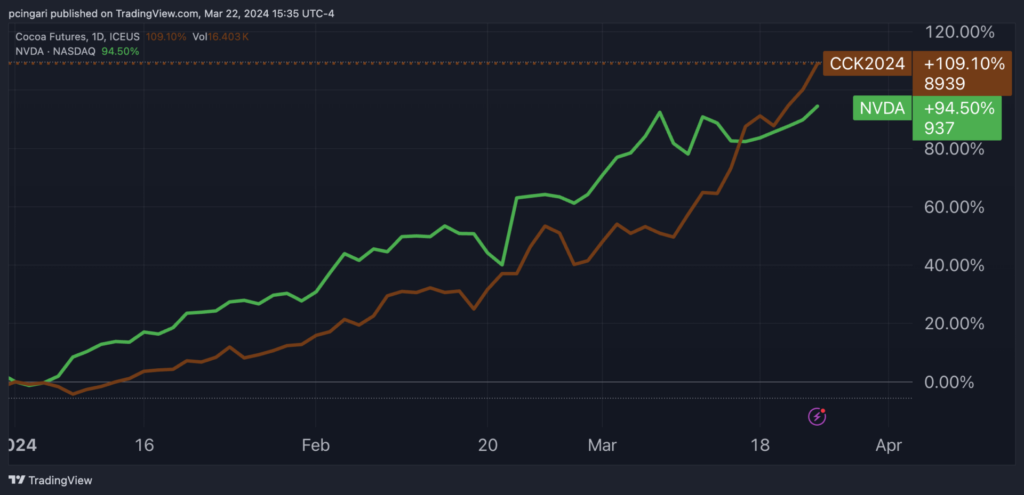Zinger Key Points
- Cocoa prices hit a historic peak, driving the agricultural raw material basket to its highest in 9+ years, worrying chocolate fans worldwide
- DBA ETF up 15% YTD to $24.09/share, with cocoa's 112% surge leading the charge, outperforming top stocks like Nvidia.
- Feel unsure about the market’s next move? Copy trade alerts from Matt Maley—a Wall Street veteran who consistently finds profits in volatile markets. Claim your 7-day free trial now.
The price of an agricultural raw material basket has reached its highest level in more than nine years, driven by the skyrocketing surge in cocoa costs, stirring concerns among chocolate lovers around the globe.
The Invesco DB Agriculture Fund DBA which tracks a broad group of agricultural commodities rose to $24.09 per share on Friday, marking an over 15% increase year to date and achieving heights last seen in mid-January 2015.
Cocoa, which holds a weight of 21% in the DBA ETF, has seen its price rise by 112% year to date, outperforming stocks like Nvidia Corp. NVDA.
Cocoa futures have skyrocketed to nearly $9,000 per ton this week, setting a new historic peak.
Chart: Skyrocketing Cocoa Prices Turn Chocolate Bars More Valuable Than AI GPUs

This dramatic increase is largely attributed to persistent concerns over tight supplies from West Africa, a region pivotal to global cocoa production.
These supply disruptions generate a significant imbalance in the global cocoa market, as the world is consuming much more cocoa than it can produce, leading to a sharp increase in prices.
Recent reports have heightened anxieties within the industry. As Reuters reported last week, major cocoa processing plants in the Ivory Coast and Ghana, countries that collectively produce nearly 60% of the world’s cocoa, have halted or reduced operations.
The inability to afford beans has been cited as a critical issue, prompting predictions of soaring chocolate prices worldwide. Chocolate manufacturers, already grappling with the repercussions of three consecutive years of poor harvests and anticipating a fourth, have begun to pass on the cost to consumers.
According to Steve Wateridge, head of research at Tropical Research Services, a massive demand destruction is needed to balance out the supply destruction.
Essentially, this means reducing the consumption of cocoa to levels that the current supply can sustain. However, achieving this in practice is challenging, especially given the global affection for chocolate.
The International Cocoa Organization (ICCO) has projected a stark outlook for the global cocoa market, predicting that the deficit for the 2023/24 season would expand dramatically to 374,000 metric tons (MT) from 74,000 MT in the previous season. This anticipated deficit is largely due to adverse growing conditions and prevalent crop diseases.
For chocolate enthusiasts, the notion of reducing demand likely translates to consuming less chocolate or facing higher prices. The latter is already happening, as chocolate manufacturers increase prices to cope with the soaring costs of raw cocoa. The former, reducing consumption, is a more direct approach to demand destruction but is a hard sell to consumers who cherish their chocolate treats.
Read now: Gold Rush Begins As Fed Hints At Rate Cuts: 5 Mining Stocks Glitter With Over 30% Rally This Month
Image generated using artificial intelligence with Midjourney.
Edge Rankings
Price Trend
© 2025 Benzinga.com. Benzinga does not provide investment advice. All rights reserved.
date | ticker | name | Price Target | Upside/Downside | Recommendation | Firm |
|---|
Trade confidently with insights and alerts from analyst ratings, free reports and breaking news that affects the stocks you care about.